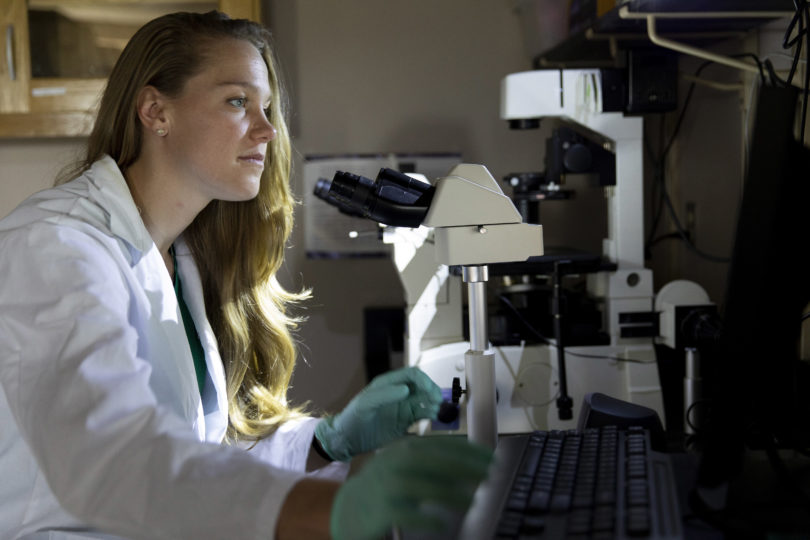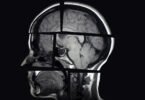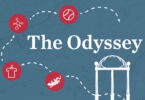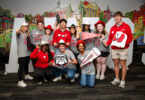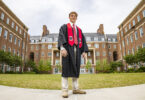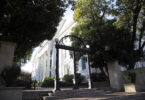Though M.D./Ph.D. student Samantha Spellicy is immersed in her work in UGA’s Regenerative Bioscience Center, she still finds time for STEM outreach and official roles in graduate student academic associations. And of course there’s always time for Bulldog tailgating.
Hometown:
Lanham, MD
High school:
Elizabeth Seton High School, Bladensburg, MD
Current employment:
M.D./Ph.D. student researcher in the lab of Steven Stice
Family ties to UGA:
I am the first member of my family to go to UGA, but I have enjoyed it so much here that I even convinced my sister to move to Athens!
Expected graduation:
Spring 2020
Degree objective:
M.D. and Ph.D. in Neuroscience
Other degrees:
B.S. in Physiology and Neurobiology from the University of Maryland
University highlights, achievements, awards and scholarships:
I am extremely grateful for the opportunities, experiences and connections I have made during my time here as a graduate student at the University of Georgia. I feel extremely fortunate to be working on my Ph.D. at a university in a great lab and in a program that is so immersive and supportive. Outside of my day-to-day laboratory and scientific pursuits, I have had the opportunity to serve in various leadership, community service and professional capacities, which have really enriched my time as a graduate student, and I’d love to share here!
After successfully finishing my first two years of medical school at the Medical College of Georgia at Augusta University, I came straight to the University of Georgia to begin my graduate Ph.D. training. When starting my graduate education, I was really impressed by how large and inclusive the graduate community was. I really wanted to get more involved with my peers and the greater Athens community, so I assumed a role on the executive board of the Graduate Research Assistants for Diversifying STEM (GRADS) organization. I was (and still am) a passionate supporter about the mission of this group, to encourage diversity in science, technology, engineering and math and to inspire students in all forms and levels through building a system of support, collegiality and mentorship. Through GRADS I was able to connect with fellow graduate students across campus and participate in multiple professional development opportunities, such as creating individual development plans for myself and science outreach opportunities such as actively engaging K-5 students in classroom experiments during “Super Scientist Week.”
This wonderful introduction to the UGA graduate community solidified a passion for service and engagement and inspired me to continue serving on other graduate student association boards. Namely, the Regenerative Bioscience Center (RBC) Graduate Student Association (GSA), where I first served as the community outreach chair, and now co-president, and the Neuroscience GSA as the professional development chair. Through this experience I have been able to connect with graduate students within the RBC as well as other graduate organizations to host professional development events, such as organizing and hosting our yearly symposium and community service events, to volunteering as a judge at local and statewide science fairs and creating social events such as the new unique “Paint your PI” event where all trainees and students in a lab worked together to paint their academic mentors. After seeing all of the amazing, wonderful and groundbreaking scientific work done by students and labs in the RBC, I was inspired to create a novel outreach opportunity to share this work with students in local schools or communities. With help from the RBC GSA, I created a “Scientific Poster Drive” where RBC students kindly donate their old scientific posters, which showcase their work and scientific accomplishments, to local middle and high schools. Posters are then used by teachers as classroom decorations, inspirational material, and even as introductions to the type of scientific work done at the UGA and RBC, serving as teaching and learning aids for more advanced classes. I was blown away with how many poster donations we received and am so excited to share these posters with school districts in Athens-Clarke and Cobb County over the next few months.
These types of leadership and community service experiences I have had here at UGA have truly prepared and inspired me to continue to pursue leadership roles on a national level as I move forward in my career as an aspiring physician scientist. I was fortunate to be elected as the Policy Committee co-chair for the American Physician Scientist Association (APSA), as well as serve as a delegate to the American Medical Association on behalf of APSA this upcoming year. Through these positions I will be able to take the experiences and knowledge I have gained while at UGA and the Medical College of Georgia into resolutions and eventually scientific and academic policy that will have lasting effects to enhance the lives of students and patients moving forward.
Outside of advocacy and the pursuit of national policy, working inside the lab, I am currently seeking to help patients and chronic disease sufferers in a different way. As a member of the Stice laboratory, my lab mates and I are working to development better therapeutics for neurodegenerative diseases and conditions such as stroke and Parkinson’s disease. We specifically are working to better understand, test and develop a novel therapeutic derived from neural stem cells that has already shown great promise in many models as a potential therapeutic for stroke. This therapeutic, called neural stem cell derived extracellular vesicles (NSCEVs) are small nanosized vesicles naturally secreted by cells that contain protein, mRNA and miRNA, and much more. Through testing in different models, we have found that this therapeutic does improve many of the symptoms of stroke, such as difficulty with limb movement and coordination measured through gait testing, and even has been shown to decrease the size of the stroke itself! I am really excited about the potential of this therapeutic and I owe all my training and laboratory skills in this area to my lab, the Steven Stice lab, here at UGA. They were one of the first to recognize the therapeutic potential of these vesicles, and we all have hit the ground running ever since.
Through the unparalleled collaborative environment in the RBC, I have had the opportunity to not only focus on my main project involving stroke, but to also work on other diseases such as Parkinson’s and Traumatic Brain Injury with the help of many different labs and colleagues. Through these projects, I have learned the intricacies of unique disease models and technical skills from the experts themselves, which has personally enhanced my development as a well-rounded scientist.
I have been fortunate enough to have the opportunity to travel to different conferences and symposia across the United States to formally present my scientific work through oral and poster presentations. Through these experiences I have had the honor of being selected for a variety of awards, including a poster presentation award at the Southern Translational Education and Research (STaR) Conference and an oral presentation award at the Regenerative Bioscience Center and Animal and Dairy Science Center Fellows Symposium, to name a few. These experiences have not only enhanced my presentation skills and storybook ability to effectively convey my research to various audiences, but also afforded me the confidence to apply for this year’s graduate school-wide three-minute thesis competition (3MT). In this competition, which compels graduate students from a range of disciplines to summarize their entire thesis work down to a three-minute talk for non-specialists, I was initially overwhelmed. After some reflection and work, I was able to mold my research into an understandable three-minute package. To my surprise, I was honored to be selected as the 2019 “People’s Choice Winner,” voted by UGA students, faculty and members of the greater Athens community. Moreover, the thrill of getting a chance to share my work with colleagues and fellow Athenians through the experience of this competition has caused me to see my research from a new streamlined lens. A social milieu that is emphasizing what I set out to do, what I have accomplished, and what I have left to do before I graduate next spring.
Recently, I have been inspired by the amazing entrepreneurship thrust and pipeline here at the University of Georgia. After participating and winning runner-up in a technology conceptualization plan competition, I decided to move forward with my computer vision-based application idea and take advantage of the wonderful startup guidance and programs here at UGA offered through Innovation Gateway. My co-founder and I recently completed the spring 2019 cohort, an I-Corps program founded by the National Science Foundation. Through this program we learned tenets of customer discovery and commercialization of research projects. This is a practice that I will surely take with me in the future. Before participation in this program, I had never really considered entrepreneurship and innovation as a possible avenue for myself, but because of the recognizable and unparalleled presence and support of the innovation community here at UGA, I felt empowered to give it a go.
Lastly, as I move forward to my final year at UGA, I am honored to be selected for the university’s 2020-2025 Strategic Planning committee. As a member of the Research, Innovation and Entrepreneurship subcommittee, we have been tasked with outlining a set of strategic goals to help promote the university’s development and excellence in these areas in the upcoming years. After spending my last few years here at the UGA, I really have developed a sense of pride, connection and appreciation for this university. I am deeply moved by this opportunity to work with administrators and faculty across campus to help shape and craft the university’s research, innovation and future entrepreneurship trajectory. I cannot imagine a better way to round out my time here as a UGA graduate student.
I chose to attend UGA because …
I always get asked this question when talking to interviewing students or undergraduates considering pursing Ph.D.s or M.D.s, and it truly was a combination of many different factors. The main answer lies in how unique the program and partnership here was between the Medical College of Georgia and University of Georgia. Through acceptance to my M.D./Ph.D. program, I could choose from a variety of schools within the Georgia state system to pursue my Ph.D. after completion of my first two years of medical school. I really liked the idea of flexibility and personalization I could have for my Ph.D. training through this partnership program, and it was something I had not seen at any other schools.
I was specifically drawn to UGA out of all the schools in the Georgia system because of the translational models used here for research. It was really important to me to undertake research with the potential to one day help people through therapeutic discovery and testing in models that recapitulate human pathology. After working with the neurology department at the Medical College of Georgia at Augusta University on clinical stroke research, I started to look for labs conducting similar stroke research which fit my very specific translational criteria. The then chief of neurology, and now dean of the Medical College of Georgia, Dr. Hess, referred me to the work of Steven Stice and close collaborator, Franklin West, for their groundbreaking translational work with neural stem cell derived therapeutics in a unique and clinically relevant porcine model. After participating in a lab rotation at UGA in the Stice lab, I learned about his prestigious history of innovation in stem cell research, therapeutics and regenerative medicine, and I was blown away. During the rest of my rotation, and in the time since, I have had the opportunity to use novel equipment such as rare microscopes, participate and scrub into surgical procedures, and learn a range of cell culture and other techniques from experts that I would have never been able to experience elsewhere. Through the labs here at the Regenerative Bioscience Center, I was really able to find exactly what I was looking for in a research training experience, with the potential to actually have a long lasting and beneficial health impact on the greater community.
My favorite things to do on campus are …
I love ending my day at the gym, playing either pickup games with friends or more formalized games outside on the Intramural Fields. I usually find it really hard to motivate myself to just plod along on a treadmill or elliptical alone, but through just playing games with friends, I completely forget I’m actually doing something active. Through joining various teams encompassing many different sports, it is just incredible how many wonderful people I have met and come to know. These people, who have become my friends in many cases, are from a range of different departments and class levels across campus. It really helped me meet a whole group of Dawgs I would have otherwise never met. Plus, after a few experiments go wrong in the lab (practically just a fact of life in research), nothing feels better than spiking a volleyball a couple of times.
When I have free time, I like …
I like to spend as much time as possible outdoors when I have some free time. One of my favorite things about Athens, whether it be a coffee shop downtown like Walker’s or a great restaurant like Cali N Tito’s in Five Points, is all the outdoor seating and porches the town has to offer. When given the option, I will always be sitting in the sun or reading in a hammock. This even goes for the end of the work day or in between experiments. It may seem a little extra to go through the trouble of leaving the lab and setting up my hammock to relax even for just five minutes, but it’s honestly one of my favorite parts of the day.
Additionally, I have always been a huge baseball and Orioles fan, so after the sun goes down, most nights I at least have a game on in the background. While the Orioles have gotten a little harder to watch in recent years, the Bulldog baseball team hasn’t! I really enjoy going to and watching UGA baseball games, and it’s always a reason to celebrate when Hairy Dawg wins the mascot race, earning dollar hotdogs for all!
The craziest thing I’ve done is …
Would you call signing up for an eight-year M.D./Ph.D. program, and then three- to seven-year residency crazy? Just kidding, I’ve actually really enjoyed this program every step of the way! The real craziest thing I have done involved some great hiking on a somewhat last-minute trip to Oahu, Hawaii, for a lab mate’s wedding. I had never really been outside of the continental U.S. and everything perfectly aligned over Thanksgiving break (with lab work and other obligations) that allowed me a chance to go. After a couple hiking excursions the day before, on the last day of the trip a friend and I decided to do a spur of the moment 4 a.m. hike up Diamondhead volcano cone. Looking at reviews of the hike, we saw most people said it was about three hours round trip, so we planned accordingly to make it to the top before sunrise (and before our flight left). As we got to the state park entrance, we were told that the top gets extremely crowded with thousands of park guests by sunrise, so we had better hustle to the top as fast as we could to get a spot on the observation deck. After a nod between my friend and I, we took off running through the state park entrance kiosk the minute it opened and up the slick winding old lava flows. Did I mention all the while in the unrelenting pitch-black darkness while trying to hold a cup of coffee? Being really motivated to be the first to the top, we decided to run the entire way to the summit and made it in just 20ish minutes! It was a thrilling, awesome and rewarding experience, with no time for views on the way up, but plenty of time once we were the sole visitors at the top. The best part is now I have 20 minutes of pitch-black go-pro footage with nothing but a jiggling camera, occasional gasps and giggles, and plodding echoing footsteps to prove it.
My favorite place to study is …
My absolute favorite place to study is Walker’s Coffee downtown. While in medical school and as an undergrad, I had only ever studied in eerily quiet environments like the library or my apartment. After convincing myself to give it a go one Saturday, I instantly fell in love. Deep booths, endless supply of caffeine, and outdoor seating usually frequented by canine friends as well, what’s not to like? I ended up enjoying studying there so much that I convinced my sister to start working at Walker’s so I’d have a friend to talk to during study breaks. Now I make up any little reason or excuse to go, such as to read just one scientific paper or get some help with my crossword puzzle. It’s also a great place to group study or bounce ideas off friends.
Before medical school, I never really had a study partner or a study group. After a few weeks in med school, I realized it’s not only nice to have study partners, but these people can be your lifeline. Whether it’s practicing teaching the material to others or hearing the material in a new light from someone else’s perspective, these groups can be the difference from just cramming the material, to learning and remembering — so much so, that it sticks with you for a lifetime. And what do you know, it only took me six years of studying to figure it out!
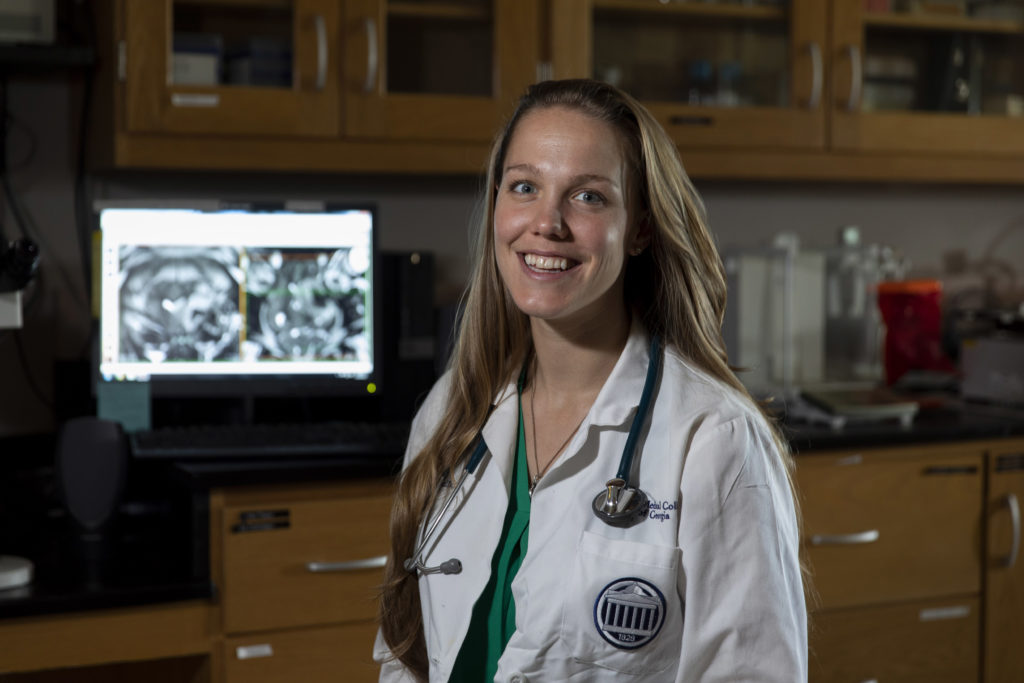 My favorite professor is …
My favorite professor is …
I have honestly had so many great professors while here at UGA it is almost impossible to narrow it down to just one. I would be remiss if didn’t first mention my Ph.D. advisor Dr. Stice. Through his lab I have learned so many new laboratory and scientific techniques that I will take with me through the rest of my scientific career. Through these experiences I have had the chance to work with rare cell lines and equipment that have truly made this Ph.D. experience unique and one of a kind.
Specially inside the classroom, however, I would have to say two of my favorites have been Jim Lauderdale, the neuroscience graduate coordinator and journal club moderator, and Jesse Schank, my neuroanatomy teacher. What is interesting is I actually appreciate their teaching for almost opposite reasons. I have really enjoyed our neuroscience journal club sessions and continue to sign up every semester even though I have technically already fulfilled my requirements. Unlike other journal clubs, which tend to have very formalized requirements or strict rules for participation in order to get credit, Dr. Lauderdale encourages that these neuroscience sessions tend to be fairly comfortable, relaxed and discussion based. It really feels like a low-pressure environment where our opinions as students on research strategies, experimental design and result validity are actually appreciated and listened to. Instead of a more traditional lecture style with a professor telling us what to take away from a paper, my peers in the neuroscience graduate program get to shape and participate in the conversation. It has just been such a great environment to meet and talk with other students in the program as well and see how far we have progressed in our scientific thinking since the first day of our training, without the fear of “getting it wrong.” I also really admire Dr. Lauderdale’s commitment to reproducibility, scientific transparency and proper controls, which honestly should be at the forefront of any scientist’s training. If I take anything home from multiple semesters in this class, hopefully it will be how to correctly design an experiment. Also, last confession, he does actually bring snacks to these sessions too, which is always a great way to make graduate students happy.
Dr. Schank’s neuroanatomy class on the other hand is more formalized with the traditional lecture style. I really enjoyed the challenge this class gave me to actually learn the material. There are some classes you can sort of just use reason and logic to get through, and anatomy is not one of those classes. I really like that Dr. Schank didn’t compromise or make any of the material easier because of this and rather just tested on what we actually need to know to be successful neuroscientists. The best part of the class, however, was the literal hands-on brain lab portions. These sessions really solidified the importance of the class for me and honestly were just a lot of fun!
Lastly, I do feel like all the faculty here and specifically neuroscience and Regenerative Bioscience Center associated faculty, are welcoming, helpful and approachable. I really feel like the students here are treated almost like pre-peers, rather than just students. Our ideas, career plans and experiments are actually listened to, and we actually get to help in the planning of a lot of events such as inviting monthly seminar speakers. It really feels like we are getting trained to actually be well-rounded, balanced, successful scientists, rather than just neuroscience fact receptacles.
If I could share an afternoon with anyone, I would love to share it with …
This was one of the hardest questions. There are a multitude of amazing remarkable pioneering women scientists that I would honestly love to talk to and spend an evening with. After a lot of thought, however, I’d have to go in a completely different direction and say Adam Jones, a centerfielder who played 10 seasons with the Orioles. Although he is an amazing defensive and offensive baseball player (and cook I hear), that’s not the reason I picked him. The real reason lies in how genuine, selfless and inspirational of a person he is. Growing up near the area, you’d have to be living under a rock to not see the beneficial impact Adam Jones had on the kids in the Baltimore community through his charitable work and philanthropy. He always spent his free time giving back to the community, supporting new generations of athletes through specialized baseball camps, and surprising unsuspecting students at schools around the city. I think what’s most striking about a lot of his work is he initiated a lot of these community outreach programs and events himself, rather than sitting back and waiting for someone else. He saw a problem, and wanted to make a difference, which is an amazing quality I hope to one day fully cultivate in myself. He also has proven to be a great spokesman to encourage students and youth groups from underrepresented backgrounds, which is also something near and dear to my heart. I feel like I could learn so much from him about motivation, perseverance, philanthropy and humility I would love an evening to discuss it all. Lastly, he happens to be a pretty goofy guy, and is known for blowing huge bubblegum bubbles while making amazing diving catches, or pie-ing teammates in the face usually when they are doing on-camera interviews after the game. All around I think it would be a great afternoon!
If I knew I could not fail, I would …
… undertake some more artistically inclined hobbies, such as painting, photography or maybe even ceramics. I think science can be so beautiful sometimes, whether it’s the way a certain slide or stained cells look under a microscope or in the natural patterns and paths cells make as they grow and move around in a dish. All day I see amazing things, micro- and macro-sized, and it would be amazing to convey if I could somehow transfer all those to a more permanent medium. Note, I have had my fair share of making figures for publications or diagrams for scientific presentations with programs such as Illustrator and Photoshop, but when I try to actually put pen or brush to paper … it never comes out as I intended. If there are any UGA artists out there who could teach me a thing or two I would be forever grateful!
If money was not a consideration, I would love to …
… just be a professional student forever. Once I finish my training here, I would love to just travel around the world visiting and learning from different labs and hospitals, almost like a never-ending sabbatical. There is so much we can learn from each other, just even in having conversations or seeing someone else in action in their lab from different cultures and backgrounds. I think it would be such an enriching experience. Also, until I started graduate school, I had never really even been off the East Coast, so I would love any excuse to travel and see more of the world! Alas, I do not think I’ll be eligible for a permanent sabbatical before I even start working.
What is your passion and how are you committed to pursuing it?
My passion is science and health care for all of course! While I do have a passion for my own science and medical pursuits surrounding therapeutic development and regenerative medicine, I also realize not everyone has even been given the same opportunities and access to education and health care as I have. Growing up in an urban D.C. area, I saw a lot of my friends and peers from different backgrounds who weren’t afforded the same opportunities or encouraged to truly pursue their own scientific passions or dreams of being a doctor. I, myself, was even discouraged away from a science career originally, but I eventually found my way back to my true passion ( I mean, when I was in trouble as a kid, I was told I couldn’t watch Magic School Bus or Bill Nye the Science Guy that night and would be absolutely distraught, so I probably should have known then). I just want to make sure every student and young budding doctor or scientist has the support, confidence and resources available to pursue their own STEM dreams. While some of the community and STEM outreach projects I am involved with now have begun on a small scale just in the Athens and surrounding areas, I’m hoping that one day they can branch out and become a far-reaching impactful network with the help of great inspirational educators and teachers across the country!
After graduation, I plan to …
I plan to first finish my last two years of medical school back in Augusta or one of the accompanying satellite campuses (fingers crossed for Athens or Savannah!). After that I will pursue a residency in neurology, neurosurgery or pediatric neurology. Even though I haven’t done enough medical rotations to really figure out which of those specialties I want to pursue yet, one thing is for sure: It’s going to be brain related! After that I would love to find a great academic hospital to work in where I could split my time between clinical work such as seeing and helping patients, academic research work, and playing with cells in the lab. Oh, and of course the best part of any academic based career, teaching! I would love to bring some of my experiences and knowledge to the classroom for a whole new generation of physicians, scientists, or both!
The one UGA experience I will always remember will be …
Not sure if I can narrow it down to just one specific event, but I’ll choose a reoccurring one that I have grown to love. Of course, I am talking about tailgating on campus for UGA football games. I had never really tailgated that much at my own undergraduate school, the University of Maryland (sorry Maryland football), so it was a couple weeks into the SEC season of my first year here until I really got it. Since then I have found a great group of friends whom I go tailgating with every game now! We usually have a great spot, food, TVs and tons of lawn games to play. It has just become a great excuse to hang outside all day with a group of friends while eating great food, so what’s not to like. These weekends have become even more special because I have recently convinced some of my friends from back home and across the U.S. to come down on specific weekends just for tailgates here! It’s been great to share a part of my experiences here at UGA with old friends, and I think they are even falling a little in love with SEC football. Now the weekends in Athens, which used to be fairly UGA-specific experiences, also now remind me of home, good friends, and appreciation for how far I have come, and how happy I am to be here today.


